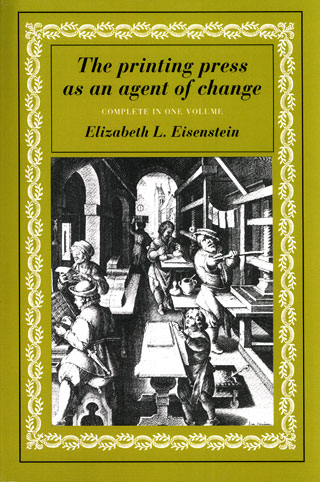Elizabeth L. Eisenstein: The Printing Press as an Agent of Change: Communications and Cultural Transformations in Early-Modern Europe (1979)
Filed under book | Tags: · advertising, antiquity, book, cartography, catalogue, censorship, history of science, image, library, literacy, mathematics, media history, memory, philology, print, propaganda, religion, renaissance

“A key text to understand the role of print on social change and the arts. Professor Eisenstein begins by examining the general implications of the shift from script to print, and goes on to examine its part in three of the major movements of early modern times – the Renaissance, the Reformation, and the rise of modern science. Her masterful and well researched text sets a standard for understanding the social impact of printing.”
Publisher Cambridge University Press, 1979
11th printing, 2005
ISBN 052129951, 9780521299558
794 pages
HT Didgebaba
Reviews: Carolyn Marvin (Technology and Culture, 1979), Anthony T. Grafton (Journal of Interdisciplinary History, 1980), Eric J. Freeman (Medical History, 1981), Eric J. Leed (American Journal of Sociology, 1982), Richard Teichgraeber (History of European Ideas, 1984).
PDF (2 vols., 16 MB, updated on 2022-1-30)
EPUB (2nd ed., 2012, added on 2022-1-30)
See also the collection Agent of Change: Print Culture Studies after Elizabeth L. Eisenstein (2007).
Comment (0)Pamela H. Smith: The Body of the Artisan: Art and Experience in the Scientific Revolution (2004)
Filed under book | Tags: · alchemy, art, art history, craft, epistemology, history of science, knowledge, natural philosophy, painting, renaissance, science, scientific revolution, technique

“Since the time of Aristotle, the making of knowledge and the making of objects have generally been considered separate enterprises. Yet during the late sixteenth and early seventeenth centuries, the two became linked through a “new” philosophy known as science. In The Body of the Artisan, Pamela H. Smith demonstrates how much early modern science owed to an unlikely source-artists and artisans.
From goldsmiths to locksmiths and from carpenters to painters, artists and artisans were much sought after by the new scientists for their intimate, hands-on knowledge of natural materials and the ability to manipulate them. Drawing on a fascinating array of new evidence from northern Europe including artisans’ objects and their writings, Smith shows how artisans saw all knowledge as rooted in matter and nature. With nearly two hundred images, The Body of the Artisan provides astonishingly vivid examples of this Renaissance synergy among art, craft, and science, and recovers a forgotten episode of the Scientific Revolution-an episode that forever altered the way we see the natural world.”
Publisher University of Chicago Press, 2004
ISBN 0226763994, 9780226763996
x+367 pages
Reviews: Ashley D. West (CAA Reviews, 2004), Marjorie Harth (Pomona, 2004), Eileen Reeves (Renaissance Quarterly, 2005), William Eamon (Isis, 2006), John Henry (British Journal for the History of Science, 2006), Jonathan Sheehan (American Historical Review, 2006), Klaas van Berkel (BMGN, 2006), Trevor Marchand (Senses and Society Journal, 2008).
PDF (51 MB, updated on 2020-5-1)
Comments (2)Victor Coelho (ed.): Music and Science in the Age of Galileo (1992)
Filed under book | Tags: · astronomy, experiment, history of science, mathematics, music, music history, renaissance, science, scientific revolution

“Music and Science in the Age of Galileo features twelve essays by leading specialists in the fields of musicology, history of science, astronomy, philosophy, and instrument building that explore the relations between music and the scientific culture of Galileo’s time. The essays take a broad historical approach towards understanding such topics as the role of music in Galileo’s experiments and in the scientific revolution, the musical formation of scientists, Galileo’s impact on the art and music of his time, the scientific knowledge of instrument builders, and the scientific experiments and cultural context of Galileo’s father, Vincenzo Galilei. This volume opens up new areas in both musicology and the history of science, and twists together various strands of parallel work by musicians and scientists on Galileo and his time.”
Publisher Kluwer, Dordrecht, 1992
Reprinted by Springer, 1992
The Western Ontario Series in Philosophy of Science series, Volume 51
ISBN 9789048142187
247 pages
Review (Rhonda Martens, Journal for the History of Astronomy, 1997)
Comment (0)
